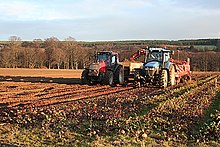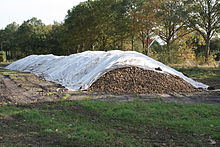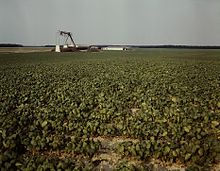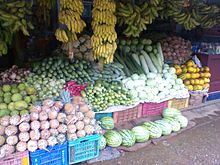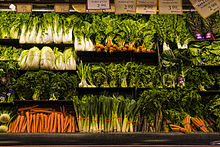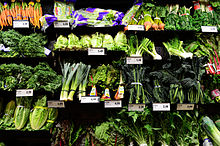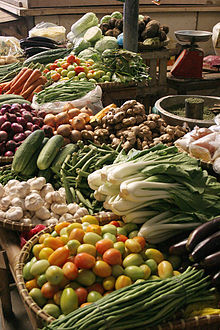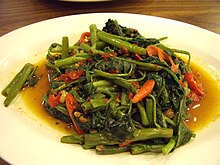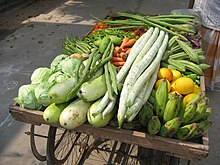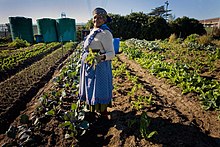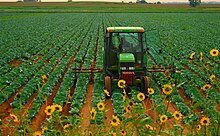Vegetable
"Veggie" redirects here. For the diet which only contains plants, see Veganism. For other uses, see Vegetable (disambiguation).
Vegetables in a market in the Philippines
In everyday usage, a
vegetable is any part of a plant that is consumed by humans as food as part of a savory meal. The term
vegetable
is somewhat arbitrary, and largely defined through culinary and
cultural tradition. It normally excludes other food derived from plants
such as fruits, nuts, and cereal grains, but includes seeds such as pulses. The original meaning of the word
vegetable, still used in biology, was to describe all types of plant, as in the terms "vegetable kingdom" and "vegetable matter".
Originally, vegetables were collected from the wild by hunter-gatherers
and entered cultivation in several parts of the world, probably during the period 10,000 BC to 7,000 BC, when a new agricultural way of life
developed. At first, plants which grew locally would have been
cultivated, but as time went on, trade brought exotic crops from
elsewhere to add to domestic types. Nowadays, most vegetables are grown
all over the world as climate permits, and crops may be cultivated in
protected environments in less suitable locations. China
is the largest producer of vegetables, and global trade in agricultural
products allows consumers to purchase vegetables grown in faraway
countries. The scale of production varies from subsistence farmer
supplying the needs of their family for food, to agribusinesses
with vast acreages of single-product crops. Depending on the type of
vegetable concerned, harvesting the crop is followed by grading,
storing, processing and marketing.
Vegetables can be eaten either raw or cooked and play an important
role in human nutrition, being mostly low in fat and carbohydrates, but
high in vitamins, minerals and fiber. Many nutritionists encourage
people to consume plenty of fruit and vegetables, five or more portions a
day often being recommended.
Etymology
Domestic vegetable garden in the United Kingdom
The word
vegetable was first recorded in English in the early 15th century. It comes from
Old French,
[1] and was originally applied to all plants; the word is still used in this sense in biological contexts.
[2] It derives from
Medieval Latin vegetabilis "growing, flourishing" (i.e. of a plant), a semantic change from a
Late Latin meaning "to be enlivening, quickening".
[1]
The meaning of "vegetable" as a "plant grown for food" was not established until the 18th century.
[3]
In 1767, the word was specifically used to mean a "plant cultivated for
food, an edible herb or root". The year 1955 noted the first use of the
shortened, slang term "veggie".
[4]
As an
adjective, the word
vegetable
is used in scientific and technical contexts with a different and much
broader meaning, namely of "related to plants" in general, edible or not
— as in
vegetable matter,
vegetable kingdom,
vegetable origin, etc.
[2]
Some common vegetables
| Some common vegetables |
| Image |
Description |
Parts used |
Origin |
Cultivars |
World production
(×106 tons, 2012)[17] |
 |
cabbage
Brassica oleracea |
leaves, axillary buds, stems, flowerheads |
Europe |
cabbage, red cabbage, Savoy cabbage, kale, Brussels sprouts, kohlrabi, cauliflower, broccoli, Chinese broccoli |
70.1 |
 |
turnip
Brassica rapa |
tubers, leaves |
Asia |
turnip, rutabaga, Chinese cabbage, napa cabbage, bok choy, collard greens |
|
 |
radish
Raphanus sativus |
roots, leaves, seed pods, seed oil, sprouting |
Southeastern Asia |
radish, daikon, seedpod varieties |
|
 |
carrot
Daucus carota |
root tubers |
Persia |
carrot |
36.9[n 1] |
 |
parsnip
Pastinaca sativa |
Root tubers |
Eurasia |
parsnip |
|
 |
beetroot
Beta vulgaris |
tubers, leaves |
Europe, Near East and India |
beetroot, sea beet, Swiss chard, sugar beet |
|
 |
lettuce
Lactuca sativa |
leaves, stems, seed oil |
Egypt |
lettuce, celtuce |
24.9 |
 |
beans
Phaseolus vulgaris
Phaseolus coccineus
Phaseolus lunatus |
pods, seeds |
Central and South America |
green bean, French bean, runner bean, haricot bean, Lima bean |
44.6[n 2] |
 |
broad beans
Vicia faba |
pods, seeds |
North Africa
South and southwest Asia |
broad bean |
|
 |
peas
Pisum sativum |
pods, seeds, sprouting |
Mediterranean and Middle East |
pea, snap pea, snow pea, split pea |
28.9[n 2] |
 |
potato
Solanum tuberosum |
root tubers |
South America |
potato |
365.4 |
 |
aubergine/eggplant
Solanum melongena |
fruits |
South and East Asia |
eggplant (aubergine) |
48.4 |
 |
tomato
Solanum lycopersicum |
fruits |
South America |
tomato, see also list of tomato cultivars |
161.8 |
 |
cucumber
Cucumis sativus |
fruits |
Southern Asia |
cucumber, see also list of cucumber varieties |
65.1 |
 |
pumpkin/squash
Cucurbita spp. |
fruits, flowers |
Mesoamerica |
pumpkin, squash, marrow, zucchini (courgette), gourd |
24.6 |
 |
onion
Allium cepa |
bulbs, leaves |
Asia |
onion, spring onion, scallion, shallot, see also list of onion cultivars |
87.2[n 2] |
 |
garlic
Allium sativum |
bulbs |
Asia |
garlic |
24.8 |
 |
leek
Allium ampeloprasum |
leaf sheaths |
Europe and Middle East |
leek, elephant garlic |
21.7 |
 |
pepper
Capsicum annuum |
fruits |
North and South America |
pepper, bell pepper, sweet pepper |
34.5[n 2] |
 |
spinach
Spinacia oleracea |
leaves |
Central and southwestern Asia |
spinach |
21.7 |
 |
yam
Dioscorea spp. |
tubers |
Tropical Africa |
yam |
59.5 |
 |
sweet potato
Ipomoea batatas |
tubers, leaves, shoots |
Central and South America |
sweet potato, see also list of sweet potato cultivars |
108.0 |
 |
cassava
Manihot esculenta |
tubers |
South America |
cassava |
269.1 |
Nutrition and health
Vegetables play an important role in human nutrition. Most are low in fat and calories but are bulky and filling.
[18]
They supply dietary fibre and are important sources of essential
vitamins, minerals and trace elements. Particularly important are the
antioxidant vitamins
A,
C and
E.
When vegetables are included in the diet, there is found to be a
reduction in the incidence of cancer, stroke, cardiovascular disease and
other chronic ailments.
[19][20]
Research has shown that, compared with individuals who eat less than
three servings of fruits and vegetables each day, those that eat more
than five servings have an approximately twenty percent lower risk of
developing coronary heart disease or stroke.
[21] The
nutritional content of vegetables varies considerably; some contain useful amounts of
protein though generally they contain little
fat,
[22] and varying proportions of
vitamins such as
vitamin A,
vitamin K and
vitamin B6,
provitamins,
dietary minerals and
carbohydrates. Vegetables contain a great variety of other
phytochemicals (bioactive non-nutrient plant compounds), some of which have been claimed to have
antioxidant,
antibacterial,
antifungal,
antiviral and
anticarcinogenic properties.
[23][24]
However, vegetables often also contain
toxins and
antinutrients which interfere with the absorption of nutrients. These include
α-solanine,
α-chaconine,
[25] enzyme inhibitors (of
cholinesterase,
protease,
amylase, etc.),
cyanide and
cyanide precursors,
oxalic acid and others.
[citation needed]
These toxins are natural defenses, used to ward off the insects,
predators and fungi that might attack the plant. Some beans contain
phytohaemagglutinin, and cassava roots contain
cyanogenic glycoside as do
bamboo shoots. These toxins can be deactivated by adequate cooking. Green potatoes contain
glycoalkaloids and should be avoided.
[26]
Fruit and vegetables, particularly leafy vegetables, have been implicated in nearly half the
gastrointestinal infections caused by
norovirus
in the United States. These foods are commonly eaten raw and may become
contaminated during their preparation by an infected food handler.
Hygiene is important when handling foods to be eaten raw, and such
products need to be properly cleaned, handled and stored to limit
contamination.
[27]
Dietary recommendations
The USDA Dietary Guidelines for Americans recommends consuming five to nine servings of fruit and vegetables daily.
[28]
The total amount consumed will vary according to age and gender, and is
determined based upon the standard portion sizes typically consumed, as
well as general nutritional content. Potatoes are not included in the
count as they are mainly providers of starch. For most vegetables and
vegetable juices, one serving is half of a cup and can be eaten raw or
cooked. For leafy greens, such as
lettuce and
spinach, a single serving is typically a full cup.
[29] A variety of products should be chosen as no single fruit or vegetable provides all the nutrients needed for health.
[21]
International dietary guidelines are similar to the ones established by the USDA.
Japan, for example, recommends the consumption of five to six servings of vegetables daily.
[30] French recommendations provide similar guidelines and set the daily goal at five servings.
[31] In India, the daily recommendation for adults is 275 grams (9.7 oz) of vegetables per day.
[19]
Cultivation
Growing vegetables in South Africa
Vegetables have been part of the human diet from
time immemorial.
Some are staple foods but most are accessory foodstuffs, adding variety
to meals with their unique flavors and at the same time, adding
nutrients necessary for health. Some vegetables are
perennials but most are
annuals and
biennials,
usually harvested within a year of sowing or planting. Whatever system
is used for growing crops, cultivation follows a similar pattern;
preparation of the soil by loosening it, removing or burying weeds and
adding organic manures or fertilisers; sowing seeds or planting young
plants; tending the crop while it grows to reduce weed competition,
control pests and provide sufficient water; harvesting the crop when it
is ready; sorting, storing and marketing the crop or eating it fresh
from the ground.
[32]
Different soil types suit different crops, but in general in
temperate climates, sandy soils dry out fast but warm up quickly in the
spring and are suitable for early crops, while heavy clays retain
moisture better and are more suitable for late season crops. The growing
season can be lengthened by the use of
fleece,
cloches,
plastic mulch,
polytunnels and
greenhouses.
[32]
In hotter regions, the production of vegetables is constrained by the
climate, especially the pattern of rainfall, while in temperate zones,
it is constrained by the temperature and day length.
[33]
Weeding cabbages in Colorado, US
On a domestic scale, the spade, fork and hoe are the tools of choice
while on commercial farms a range of mechanical equipment is available.
Besides tractors, these include
ploughs,
harrows,
drills,
transplanters,
cultivators,
irrigation equipment and
harvesters. New techniques are changing the cultivation procedures involved in growing vegetables with computer monitoring systems,
GPS locators and self-steer programmes for driverless machines giving economic benefits.
[33]
